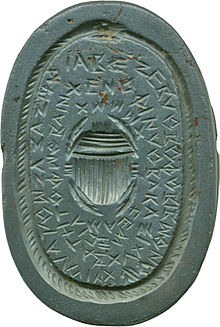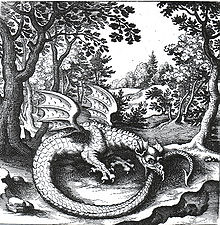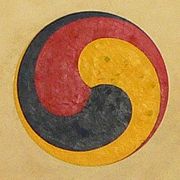Crop Circles Mystery
NOTE: THERE ARE OTHER HOOPS THAT WE LIVE WITHIN AS WELL:
THE OUROBOROS
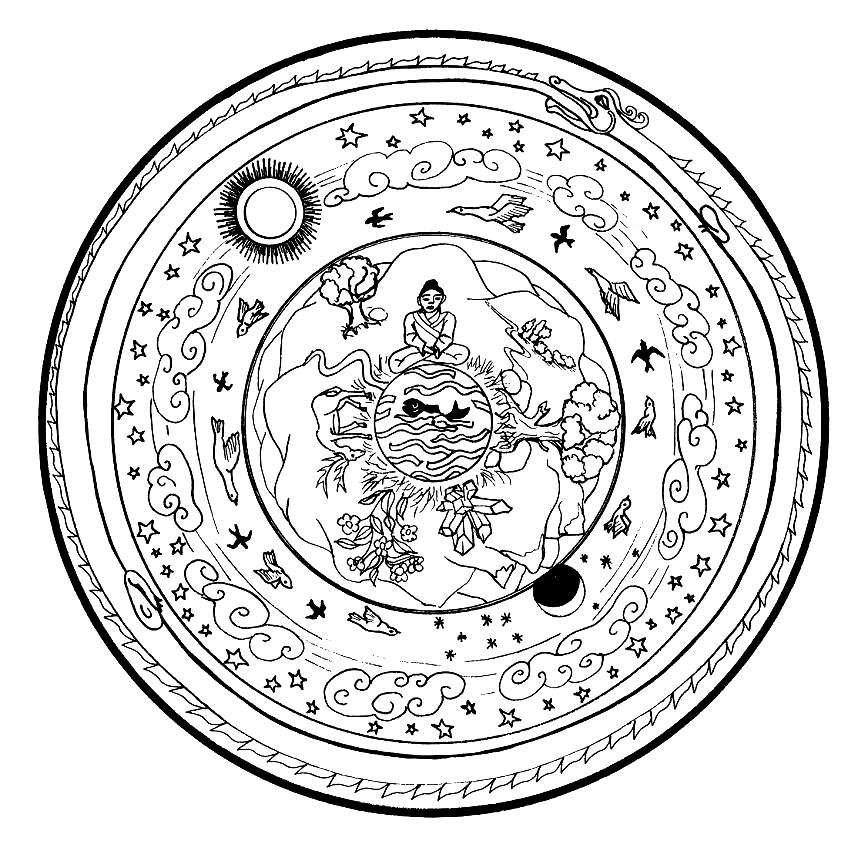
Notice the snake (Ouroboros) on the outside of the circle, consuming itself in order to sustain itself – a fundamental pattern of the life phenomenon in the universe. This is the Universe of Nimrod
The Ouroboros often represents self-reflexivity or cyclicality, especially in the sense of something constantly re-creating itself, the eternal return, and other things perceived as cycles that begin anew as soon as they end (compare with phoenix). It can also represent the idea of primordial unity related to something existing in or persisting from the beginning with such force or qualities it cannot be extinguished. The Ouroboros has been important in religious and mythological symbolism, but has also been frequently used in alchemical illustrations, where it symbolizes the circular nature of the alchemist's opus. It is also often associated with Gnosticism, and Hermeticism. Carl Jung interpreted the Ouroboros as having an archetypal significance to the human psyche.[citation needed] The Jungian psychologist Erich Neumann writes of it as a representation of the pre-ego "dawn state", depicting the undifferentiated infancy experience of both mankind and the individual child.[2]
Egypt
The first known appearance of the ouroboros motif is in the Enigmatic Book of the Netherworld, an ancient Egyptian funerary text in KV62, the tomb of Tutankhamun, in the 14th century BC. The text concerns the actions of the god Ra and his union with Osiris in the underworld. In an illustration from this text, two serpents, holding their tails in their mouths, coil around the head and feet of an enormous god, who may represent the unified Ra-Osiris. Both serpents are manifestations of the deity Mehen, who in other funerary texts protects Ra in his underworld journey. The whole divine figure represents the beginning and the end of time.[3]
The ouroboros appears elsewhere in Egyptian sources, where, like many Egyptian serpent deities, it represents the formless disorder that surrounds the orderly world and is involved in that world's periodic renewal.[4] The symbol persisted in Egypt into Roman times, when it frequently appeared on magical talismans, sometimes in combination with other magical emblems.[5] The 4th-century AD Latin commentator Servius was aware of the Egyptian use of the symbol, noting that the image of a snake biting its tail represents the cyclical nature of the year.[6]
Greece
Plato described a self-eating, circular being as the first living thing in the universe—an immortal, mythologically constructed entity.
- The living being had no need of eyes because there was nothing outside of him to be seen; nor of ears because there was nothing to be heard; and there was no surrounding atmosphere to be breathed; nor would there have been any use of organs by the help of which he might receive his food or get rid of what he had already digested, since there was nothing which went from him or came into him: for there was nothing beside him. Of design he created thus; his own waste providing his own food, and all that he did or suffered taking place in and by himself. For the Creator conceived that a being which was self-sufficient would be far more excellent than one which lacked anything; and, as he had no need to take anything or defend himself against any one, the Creator did not think it necessary to bestow upon him hands: nor had he any need of feet, nor of the whole apparatus of walking; but the movement suited to his spherical form which was designed by him, being of all the seven that which is most appropriate to mind and intelligence; and he was made to move in the same manner and on the same spot, within his own limits revolving in a circle. All the other six motions were taken away from him, and he was made not to partake of their deviations. And as this circular movement required no feet, the universe was created without legs and without feet.[7]
In Gnosticism, this serpent symbolized eternity and the soul of the world. The Gnostic text Pistis Sophia describes the disc of the sun as a 12-part dragon with his tail in his mouth.[8]
Middle Ages
The Ouroboros symbol appears in both 14th-15th century Albigensian printing watermarks[9] and is also worked into the pip cards of many early (14th-15th century) playing cards, including Tarot cards.[10] Watermarks similar to those used by the Albigensians appear in early printed playing cards, suggesting that the Albigenses might have had contact with the early authors of tarot decks.[11] The symbol commonly used as the ace of cups in early decks, which is one of the symbols frequently circled with an ouroboros, also frequently appears among Albigensian watermarks.[12] It is conceivable that this is the source of some of the urban legends associating this symbol with secret societies,[13] because the Albigenses were closely associated with the humanist movement and the inquisition it sparked. Because the Albigenses came from Armenia, where Zoroastrianism and Mithra worship were common, it may be that the symbol entered their iconography via the Zoroastrian Faravahar symbol, which in some versions clearly features an ouroboros at the waist instead of a vague disc-shape. In Mithran mystery cults the figure of Mithra being reborn (one of the things he is famous for) is sometimes seen wrapped with an ouroboros, indicating his eternal and cyclic nature,[14] and even references which do not mention the ouroboros refer to this circular shape as symbolizing the immortality of the soul or the cyclic nature of Karma, suggesting that the circle retains its meaning even when the details of the image are obscured.[15]
In Norse mythology, it appears as the serpent Jörmungandr, one of the three children of Loki and Angrboda, who grew so large that it could encircle the world and grasp its tail in its teeth. In the legends of Ragnar Lodbrok, such as Ragnarssona þáttr, the Geatish king Herraud gives a small lindworm as a gift to his daughter Þóra Town-Hart after which it grows into a large serpent which encircles the girl's bower and bites itself in the tail. The serpent is slain by Ragnar Lodbrok who marries Þóra. Ragnar later has a son with another woman named Kráka and this son is born with the image of a white snake in one eye. This snake encircled the iris and bit itself in the tail, and the son was named Sigurd Snake-in-the-Eye.[16]
Alchemy
In alchemy, the Ouroboros is a sigil. Swiss psychologist Carl Jung saw the Ouroboros as an archetype and the basic mandala of alchemy. Jung also defined the relationship of the Ouroboros to alchemy:[17]
The alchemists, who in their own way knew more about the nature of the individuation process than we moderns do, expressed this paradox through the symbol of the Ouroboros, the snake that eats its own tail. The Ouroboros has been said to have a meaning of infinity or wholeness. In the age-old image of the Ouroboros lies the thought of devouring oneself and turning oneself into a circulatory process, for it was clear to the more astute alchemists that the prima materia of the art was man himself. The Ouroboros is a dramatic symbol for the integration and assimilation of the opposite, i.e. of the shadow. This 'feed-back' process is at the same time a symbol of immortality, since it is said of the Ouroboros that he slays himself and brings himself to life, fertilizes himself and gives birth to himself. He symbolizes the One, who proceeds from the clash of opposites, and he therefore constitutes the secret of the prima materia which [...] unquestionably stems from man's unconscious.
The famous Ouroboros drawing from the early alchemical text The Chrysopoeia of Cleopatra dating to 2nd century Alexandria encloses the words hen to pan, "one is the all". Its black and white halves represent the Gnostic duality of existence. As such, the Ouroboros could be interpreted as the Western equivalent of the Taoist Yin-Yang symbol.
The Chrysopoeia Ouroboros of Cleopatra is one of the oldest images of the Ouroboros to be linked with the legendary opus of the Alchemists, the Philosopher’s Stone.
As a symbol of the eternal unity of all things, the cycle of birth and death from which the alchemist sought release and liberation, it was familiar to the alchemist/physician Sir Thomas Browne. In his A Letter to a Friend, a medical treatise full of case-histories and witty speculations upon the human condition, he wrote of it:
[...] that the first day should make the last, that the Tail of the Snake should return into its Mouth precisely at that time, and they should wind up upon the day of their Nativity, is indeed a remarkable Coincidence,
It is also alluded to at the conclusion of Browne's The Garden of Cyrus (1658) as a symbol of the circular nature and Unity of the two Discourses:
All things began in order so shall they end, so shall they begin again according to the Ordainer of Order and the mystical mathematicks of the City of Heaven.
THE MILKY WAY
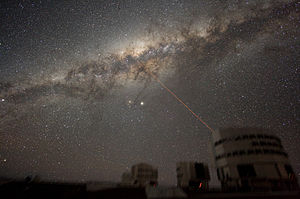
The Milky Way is the galaxy that contains our Solar System.[11][12][13][nb 1] This name derives from its appearance as a dim "milky" glowing band arching across the night sky, in which the naked eye cannot distinguish individual stars. The term "Milky Way" is a translation of the Classical Latin via lactea, from the Hellenistic Greek γαλαξίας κύκλος (pr. galaxías kýklos, "milky circle").[14][15][16] The Milky Way appears like a band because it is a disk-shaped structure being viewed from inside. The fact that this faint band of light is made up of stars was proven in 1610 when Galileo Galilei used his telescope to resolve it into individual stars. In the 1920s, observations by astronomer Edwin Hubble showed that the Milky Way is just one of many galaxies.
The Milky Way is a barred spiral galaxy 100,000–120,000 light-years in diameter containing 200–400 billion stars. It may contain at least as many planets.[17] The Solar System is located within the disk, around two thirds of the way out from the Galactic Center, on the inner edge of a spiral-shaped concentration of gas and dust called the Orion–Cygnus Arm. The stars in the inner ≈10,000 light-years are organized in a bulge and one or more bars. The very center is marked by an intense radio source named Sagittarius A* which is likely to be a supermassive black hole. The Galaxy rotates differentially, faster towards the center and slower towards the outer edge. The rotational period is about 200 million years at the position of the Sun.[8] The Galaxy as a whole is moving at a velocity of 552 to 630 km per second, depending on the relative frame of reference. It is estimated to be about 13.2 billion years old, nearly as old as the Universe. Surrounded by several smaller satellite galaxies, the Milky Way is part of the Local Group of galaxies, which forms a subcomponent of the Virgo Supercluster.
THE DHARMIC WHEEL
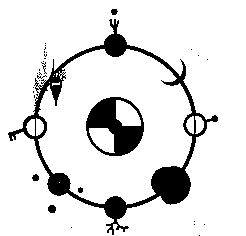
Dharmachakra (Sanskrit: धर्मचक्र; Pāli: Dhammacakka; Standard Tibetan: འཀོར་ལོ། (chos kyi 'khor lo); Burmese: ဓမ္မစကြာ (IPA: [dəməseʔ tɕà]); Chinese: 法輪; pinyin: fălún), lit. "Wheel of Dharma" or "Wheel of Life", is a symbol that has represented dharma, the Buddha's teaching of the path to enlightenment, since the early period of Indian Buddhism.[1] A similar symbol is also in use in Jainism. It is one of the Ashtamangala symbols.
The Dharmachakra is one of the oldest known Buddhist symbols found in Indian art, appearing with the first surviving post-Harappan Indian iconography in the time of the Buddhist king Aśoka.[2] It has been used by Buddhist nations as a symbol ever since. In its simplest form, the Dharmachakra is recognized globally as a symbol for Buddhism.[3]
In Buddhism—according to the Pali Canon, Vinayapitaka, Khandhaka, Mahavagga, Dhammacakkappavattanasutta—number of spokes of the Dharmacakra represent various meanings:
-
-
-
-
-
-
-
-
-
-
-
-
- 8 spokes representing the Noble Eightfold Path (Ariya magga).
- 12 spokes representing the Twelve Laws of Dependent Origination (Paticcasamuppāda) or the twelve permutations of the four noble truths.[4]
- 24 spokes representing the Twelve Laws of Dependent Origination and the Twelve Laws of Dependent Termination (Paticcasamuppāda).
- 31 spokes representing 31 realms of existence (11 realms of desire, 16 realms of form and 4 realms of formlessness).
-
-
-
-
-
-
-
-
-
-
-
In Buddhism, Parts of the Dharmacakra also representing:
-
-
-
-
-
-
-
-
-
-
-
-
- Its overall shape is that of a circle (cakra), representing the perfection of the dharma teaching
- The hub stands for discipline, which is the essential core of meditation practice
- The rim, which holds the spokes, refers to mindfulness or samādhi which holds everything together
- Each spoke represents the Noble Eightfold Path including
-
-
-
-
-
-
-
-
-
-
-
• Right beliefs • Right aspirations • Right speech • Right conduct • Right livelihood • Right effort • Right mindfulness • Right meditational attainment
The corresponding mudrā, or symbolic hand gesture, is known as the Dharmacakra Mudrā.
The Dharmachakra is one of the eight auspicious symbols of Tibetan Buddhism.
The dharma wheel can refer to the dissemination of the dharma teaching from country to country. In this sense the dharma wheel began rolling in India, carried on to Central Asia, and then arrived in South East Asia and East Asia.
Multiple turnings of the Wheel
Mahayana schools classify Buddhist teachings in turns of a sequential scheme of development. These phases are called "turnings" of the Dharmacakra (Sanskrit: dharmacakra-pravartana).
All Buddhists agree that the original turning of the wheel occurred when the Buddha taught the five ascetics who became his first disciples at the Deer Park in Sarnath. In memory of this, the Dharmacakra is sometimes represented with a deer on each side.
In Theravāda Buddhism, this was the only "turning of the wheel", and later developments of the Buddhist doctrine which do not appear in the Pali Canon or the Agamas are not accepted as teachings of the historical Buddha.
Other schools of Buddhism, such as the Mahāyāna and Vajrayāna distinguish later "turnings". Specific accounts of them vary. In one, the first turning of the Dharmacakra is Gautama Buddha's original teaching, in particular the Four Noble Truths which describes the mechanics of attachment, desire, suffering, and liberation via the Eightfold Path; the second turning is the teaching of the Perfection of Wisdom sutra, a foundational text of Mahayana Buddhism; and the third is the teaching of the Mahavairocana Sutra, a foundational text of Tantric Buddhism.
In another scheme, the second turning of the Dharmacakra is the Abhidharma, the third is the Mahāyāna Perfection of Wisdom Sutras, and the fourth includes both the Yogacara sutras and Tathāgatagarbha sutras.
In Ananda Marga, Shrii Shrii Anandamurtiji, the Spiritual Master of the modern Tantra Yoga emphasizes the practice of Dharmacakra on his teachings representing a collective Kiirtan and Meditation by the Sadhakas (Spiritual Aspirants) To create and vibrate a very positive energy that enhances the Physical Sphere, Mental Sphere and Spiritual Sphere of a the Sadhakas (Spritual Aspirants). Shrii Shrii Anandamurtiji offers the path of Sadhana to Sadhakas. He describes sadhana as "the transformation of fearful love into fearless love".[5] This meditation (sadhana) for complete merger, for unification, starts with fearful love. He recommends to his disciples the practice of collective meditation at least once a week. These meetings called Dharma Chakras are preceded by the singing of few Prabhat Samgiita (or "Songs of the New Dawn", composed by Shrii Shrii Anandamurtiji himself) followed byEZEKIEL'S WHEEL
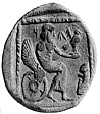
Ezekiel's Firmament
The vision of the throne of God described in the first chapter of Ezekiel included the reference to a firmament. This was a rigid structure. It was a platform, composed of a crystalline substance, which supported the throne of God. It was supported by four living creatures. This firmament or platform was described in Ezekiel 1:22-26:
And the likeness of the firmament upon the heads of the living creature was as the colour of the terrible crystal, stretched forth over their heads above. And under the firmament were their wings straight... And there was a voice from the firmament that was over their heads... And above the firmament that was over their heads was the likeness of a throne, as the appearance of a sapphire stone: and upon the likeness of the throne was the likeness as the appearance of a man above upon it.
Ezekiel's description of this crystalline firmament, together with the statement in Genesis 1 that the firmament made on the second day was named Heaven, was interpreted in medieval times as an indication that God's throne was located on top of the firmament, or the empyrean, the highest heaven. But the use of the symbol of the sapphire fits the identification of the starry heavens with God's throne. Ezekiel's account clearly shows the Hebrew word raqia referred to a solid structure. Jesus's statement identifying heaven with God's throne, the earth with his footstool, applied to Ezekiel's vision, leads to the identification of the firmament with the earth's crust.
The first and tenth chapters of Ezekiel contain descriptions of "wheels" associated with the vision of God. Some scholars consider these verses referring to the wheels to be later insertions. Klein wrote:
The most serious question about the integrity of the chapter deals with the account of the wheels. It is not clear how we are to conceive the connection of the wheels to the animals in general and to the legs in particular, and Othmar Keel has argued, convincingly in my judgment, that the wheels represent a shift from the basic idea of the vision.
Klein suggested "someone, presumably early in the traditional history of the book, found it appropriate to add wheels to the visionary scenery." In his commentary on Ezekiel 1, Carley pointed out the Septuagint does not contain verse 14. Referring to verse 15, he wrote :
The report of the vision went directly on to describe the throne of God above the heads of the living creatures (verses 22-28a). But there has been inserted a somewhat puzzling description of wheels beside the creatures... There are secondary expansions even within this section. Verse 17 anticipates the movement of the wheels referred to in verses 19f.; verse 18 elaborates the appearance of the wheels; and verse 21, which is absent from some manuscripts, largely repeats verses 19f.
Other scholars suspect the account of the "wheels" may have been inserted into Ezekiel's prophecy by a later writer. Why was there so much interest in these mysterious wheels, and so much elaboration on their properties? The answer could be that the wheels of Ezekiel represent an attempt to introduce the celestial spheres of Greek cosmology into the Scriptures.
Jewish scholars seem to have interpreted the wheels in a cosmological sense, and "the old rabbis declared that if anyone knew the secrets of the merkabah, he would know all the secrets of creation." There are similarities between the wheels and the circles or spheres of Eudoxus and Aristotle. Perhaps this is another example of cosmological editing of the Scriptures in the 2nd century BC. Some versions of the Septuagint do not contain Ezekiel 1:14 of the KJV. In the Aramaic Targum, this verse reads:
And the creatures, when they are sent to do the will of their Master who makes His Shekinah dwell on high above them, are like the eye seeing a bird on the wing, they turn and circle the world, and the creatures return together, quickly, like a flash of lightning.
Could the quick movement of the wheels, and their instantaneous return, have something to do with an attempt to explain meteors in terms of the theory of homocentric heavenly spheres? Meteors were identified with stars in ancient times, so a mechanism was needed for movements other than the regular motion of the heavens.
The wheels of Ezekiel "circle the world," they are homocentric, like the spheres of Eudoxus; one wheel is identified with the earth; they are said to be "so high that they were dreadful" (verse 18), which seems to indicate a size of cosmological proportions, and they revolved in a constant direction like the heavenly spheres of Greek philosophy. The wheels are animated; "the spirit of the living creature was in the wheels" (verse 21). This is reminiscent of the teaching of Aristotle about the nature of the heavenly spheres. There does not seem to have been any specific word for sphere in the ancient Hebrew, and the word for circle, "chug", often designated a sphere. The idea behind the word translated "wheel" seems to be that it is something revolving, as the heavenly spheres were thought to do.
From as early as the fourth century BC, gentiles of the land of Palestine identified the Hebrew Yehveh or "Iao" with one of the Greek sky-gods; sometimes Zeus, and sometimes Helios or Apollo. This seems to be illustrated on the Phoenician silver drachma at right, showing the image on a coin struck about 350 BC, now in the British Museum; it depicts a bearded divinity enthroned over a winged chariot wheel, interpreted by some scholars as a solar chariot, but quite possibly representing the rigid rotating sky of the geocentic cosmology. The deity is depicted wearing a long garment that extends to his feet; he holds an eagle on his outstretched hand; he is labelled with the letters YHW. Arthur B. Cook says there is little doubt it is a gentile representation of the Hebrew deity; "the coin represents Jehovah under the guise of a solar Zeus". There are several elements in the image that may possibly be associated with some of the concepts present in the first chapter of Ezekiel; perhaps some ancient Jewish scribe attempted to introduce imagery similar to that of this coin into Ezekiel's prophecy.
The book of Ezekiel was written about 593 BC, long before Eudoxus and Aristotle proposed their cosmologies. The account of the "wheels" in Ezekiel's prophecy may be a veiled reference to the geocentric cosmology, introduced in the Hellenistic period, superimposed onto Ezekiel's throne vision. Naturally, this procedure would produce a somewhat garbled account.
References
Carley, K.W. 1974. The book of the prophet Ezekiel. Cambridge University Press. Cambridge. p.17.
Levey, Samson H. 1987. The Targum of Ezekiel. Michael Glazier, Inc. Wilmington Delaware. p. 21.
Klein, Ralph W. 1988. Ezekiel: The prophet and his message. University of South Carolina Press. p. 18.
GALAXIES
THIS IS JUST ONE EXAMPLE
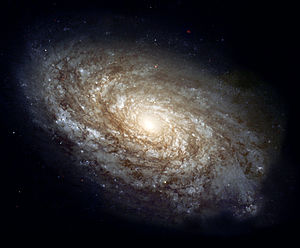
NGC 4414, a typical spiral galaxy in the constellation Coma Berenices, is about 55,000 light-years in diameter and approximately 60 million light-years away from Earth
SEE ALSO:
CONSTELLATIONS - Coma Berenices - Spiderman - The Swan
A galaxy is a massive, gravitationally bound system consisting of stars, stellar remnants, an interstellar medium of gas and dust, and an important but poorly understood component called dark matter.[1][2] The word galaxy is derived from the Greek galaxias (γαλαξίας), literally "milky", a reference to the Milky Way. Examples of galaxies range from dwarfs with as few as ten million (107) stars[3] to giants with a hundred trillion (1014) stars,[4] each orbiting their galaxy's own center of mass.
Galaxies contain varying amounts of star systems, star clusters and types of interstellar clouds. In between these objects is a sparse interstellar medium of gas, dust, and cosmic rays. Dark matter appears to account for around 90% of the mass of most galaxies[citation needed]. Observational data suggests that supermassive black holes may exist at the center of many, if not all, galaxies. They are thought to be the primary driver of active galactic nuclei found at the core of some galaxies. The Milky Way galaxy appears to harbor at least one such object.[5]
Galaxies have been historically categorized according to their apparent shape; usually referred to as their visual morphology. A common form is the elliptical galaxy,[6] which has an ellipse-shaped light profile. Spiral galaxies are disk-shaped with dusty, curving arms. Those with irregular or unusual shapes are known as irregular galaxies and typically originate from disruption by the gravitational pull of neighboring galaxies. Such interactions between nearby galaxies, which may ultimately result in a merging, sometimes induce significantly increased incidents of star formation leading to starburst galaxies. Smaller galaxies lacking a coherent structure are referred to as irregular galaxies.[7]
There are probably more than 170 billion (1.7 × 1011) galaxies in the observable Universe.[8] Most are 1,000 to 100,000 parsecs in diameter and usually separated by distances on the order of millions of parsecs (or megaparsecs). Intergalactic space (the space between galaxies) is filled with a tenuous gas of an average density less than one atom per cubic meter. The majority of galaxies are organized into a hierarchy of associations known as groups and clusters, which, in turn usually form larger superclusters. At the largest scale, these associations are generally arranged into sheets and filaments, which are surrounded by immense voids.[9]
MEDICINE WHEEL
THE NEW JERUSALEM WHEEL DIAGRAM
BLACK ELK'S SACRED HOOP
LORD OF THE RINGS
THE GEMATRIAN WHEEL
TOROUS
CHAKRAS
SUNFLOWER
FIBONACI SPIRAL
SEED OF LIFE
FLOWER OF LIFE
THE GREAT TURNING -CELTIC,
